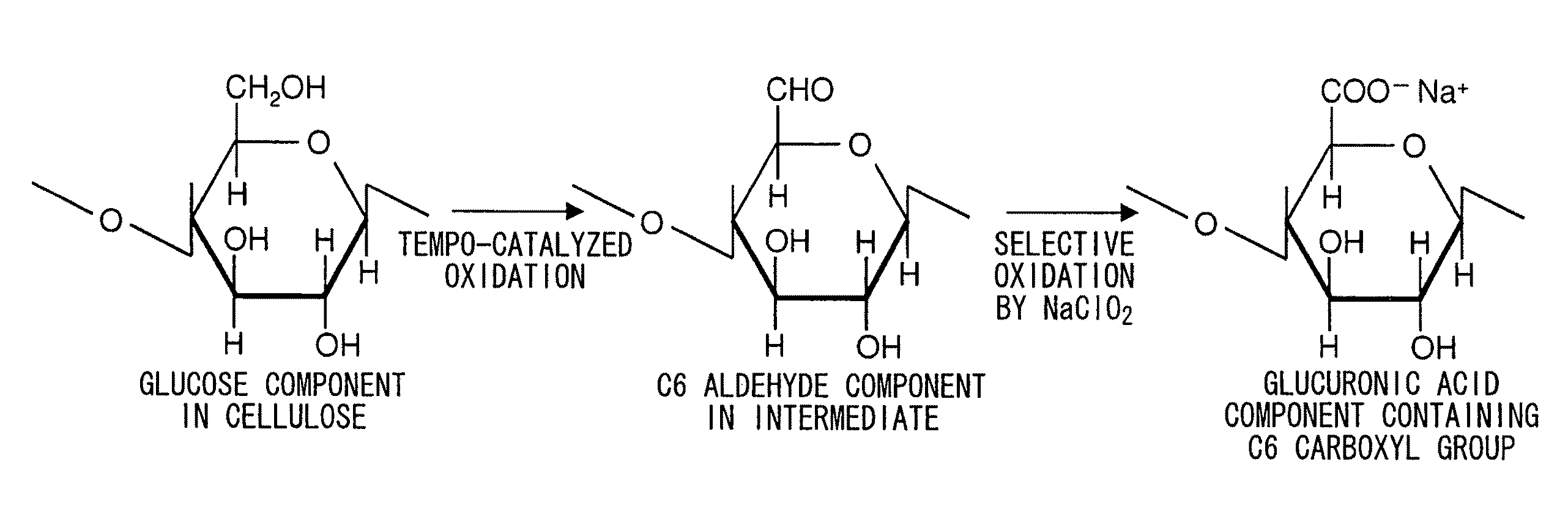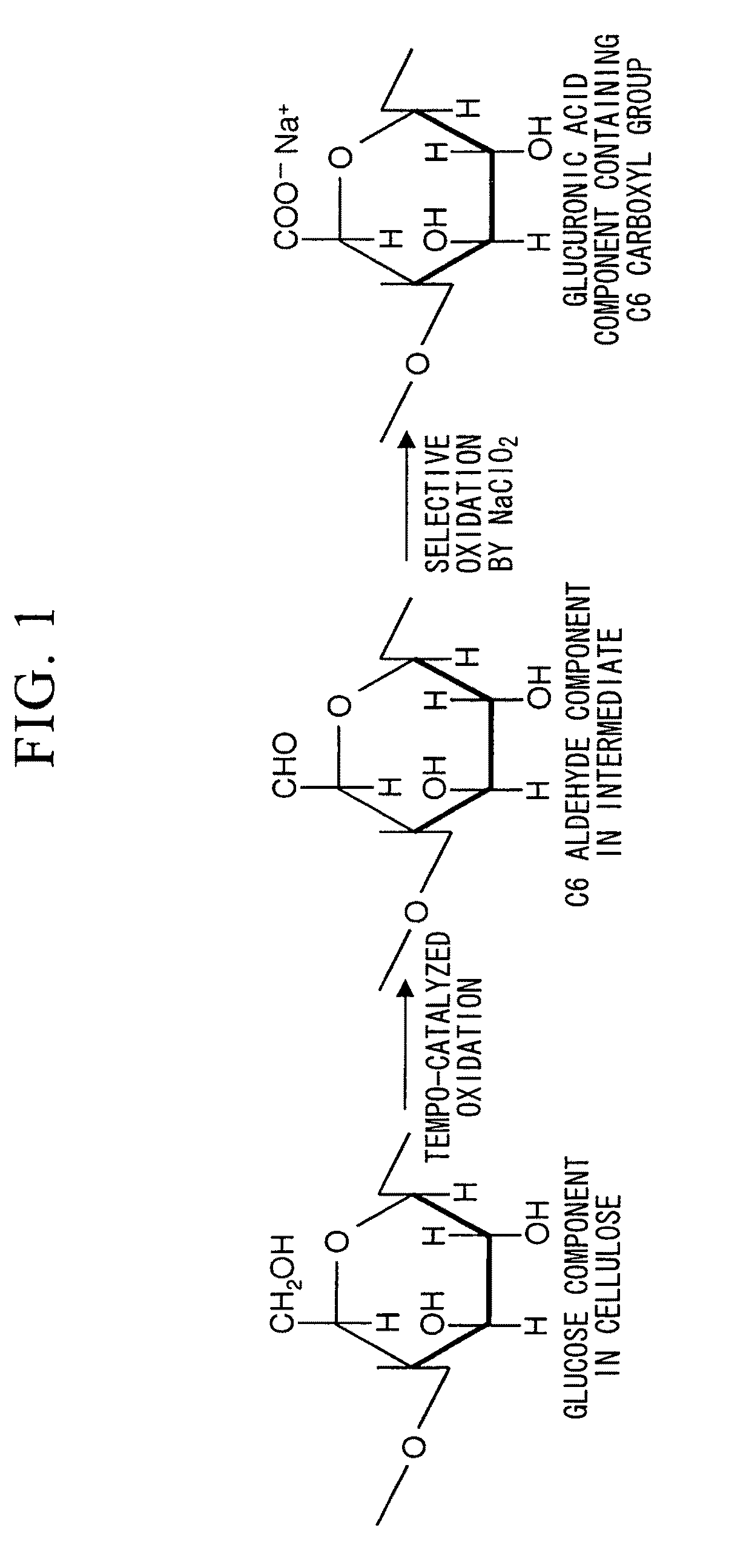Cellulose nanofiber, production method of same and cellulose nanofiber dispersion
a technology of cellulose nanofibers and production methods, which is applied in the direction of paper after-treatment, pulp properties modification, acid salt/anhydride pulping, etc., can solve the problem of inability to easily disperse into individual nanofibers, and achieve superior transparency or whiteness, high polymerization, and superior strength.
- Summary
- Abstract
- Description
- Claims
- Application Information
AI Technical Summary
Benefits of technology
Problems solved by technology
Method used
Image
Examples
example 1
[0116]In this example, an explanation is provided of the results of examining reaction pH, reaction time and reaction temperature.
[0117]Wood cellulose (1 g) was respectively dispersed in 0.1 M aqueous acetic acid adjusted to pH 3.5, 0.1 M acetate buffer adjusted to pH 4.8, and 0.1 M phosphate buffer adjusted to pH 6.8, followed by the addition of 0.1 mmol (0.0156 g) of TEMPO and 10 mmol of sodium chlorite (1.13 g of commercially available 80% sodium chlorite) to each solution in an Erlenmeyer flask, sealing the flask and stirring with a magnetic stirrer until the native cellulose was adequately dispersed.
[0118]Subsequently, 2.5 mL of an aqueous sodium hypochlorite solution having a concentration of 0.2 M were added to the reaction solution followed immediately by resealing the flask. The amount of sodium hypochlorite added at this time was 0.5 mmol based on 1 g of native cellulose.
[0119]Subsequently, the sealed reaction vessel was stirred for a prescribed amount of time (2 to 72 hou...
example 2
[0132]In this example, an explanation is provided of the results of examining the amount of sodium hypochlorite added to the reaction solution.
[0133]In this example, oxidized cellulose was prepared while varying the amount of sodium hypochlorite added to the reaction solution within the range of 0 to 1.0 mmol / g. Other conditions of the reaction solution were the same as in Example 1.
[0134]The results of defibration treatment and carboxyl group measurement in the resulting oxidized cellulose carried out in the same manner as Example 1 are shown in Table 2.
[0135]
TABLE 2Amt. of sodiumReactionAmt. of carboxyl groupshypochlorite addedtimeTemp.in oxidized cellulose(mmol / g)pH(hr)(° C.)(mmol / g)06.82600.120.36.82600.410.56.82600.481.06.82600.570.36.82400.360.36.86400.430.36.818400.500.56.82400.410.56.86400.580.56.822400.641.06.624600.67
[0136]Based on the results of Table 2, the amount of carboxyl groups in the oxidized cellulose increases with increase in the amount of sodium hypochlorite ad...
example 3
[0137]In this example, an explanation is provided of the results of examining the type of catalyst added to the reaction solution.
[0138]In this example, oxidized cellulose was prepared respectively using TEMPO and 4-acetoamide-TEMPO for the oxidation catalyst added to the reaction solution. FIG. 4 shows the chemical structures of these oxidation catalysts. Other conditions of the reaction solution were the same as in Example 1.
[0139]The results of carboxyl group measurement in the resulting oxidized cellulose carried out in the same manner as Example 1 are shown in Table 3.
[0140]
TABLE 3ReactionAmt. of carboxyltimeTemp.groups in oxidizedCatalystpH(hr)(° C.)cellulose (mmol / g)4-acetoamide-TEMPO5.022400.38TEMPO5.022400.304-acetoamide-TEMPO6.822400.68TEMPO6.822400.64
[0141]Based on the results of Table 3, improvement of efficiency of the oxidation reaction was observed as a result of using 4-acetoamide-TEMPO. However, the effect of pH on the reaction system was considerably greater. Thus,...
PUM
| Property | Measurement | Unit |
|---|---|---|
| number average fiber diameter | aaaaa | aaaaa |
| number average fiber diameter | aaaaa | aaaaa |
| diameter | aaaaa | aaaaa |
Abstract
Description
Claims
Application Information
 Login to View More
Login to View More - R&D
- Intellectual Property
- Life Sciences
- Materials
- Tech Scout
- Unparalleled Data Quality
- Higher Quality Content
- 60% Fewer Hallucinations
Browse by: Latest US Patents, China's latest patents, Technical Efficacy Thesaurus, Application Domain, Technology Topic, Popular Technical Reports.
© 2025 PatSnap. All rights reserved.Legal|Privacy policy|Modern Slavery Act Transparency Statement|Sitemap|About US| Contact US: help@patsnap.com



